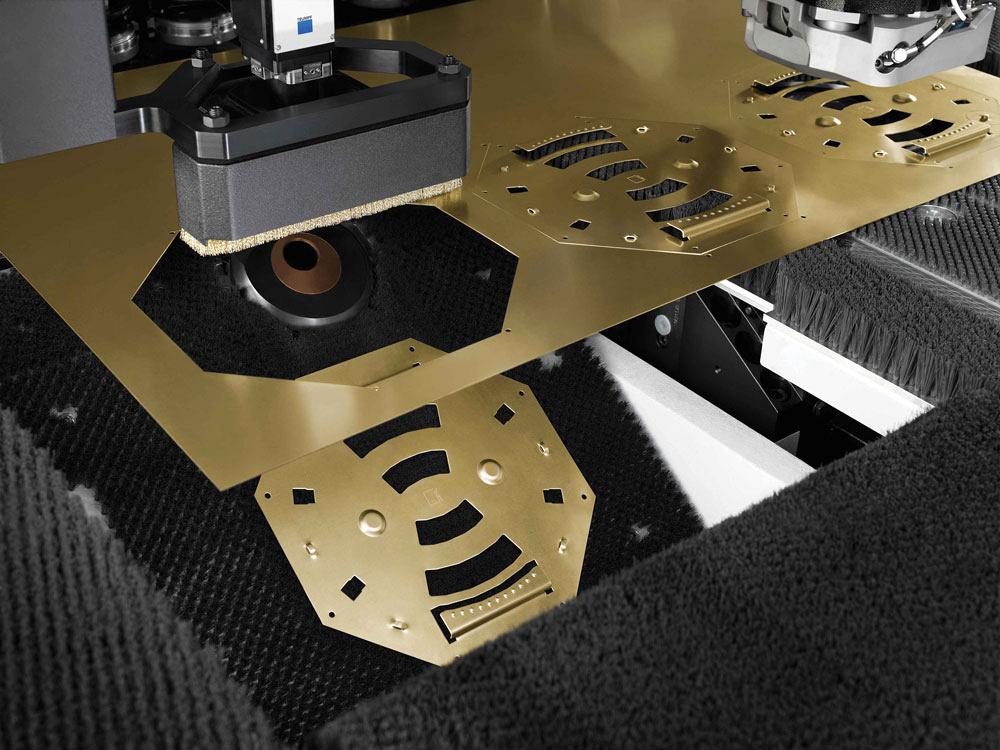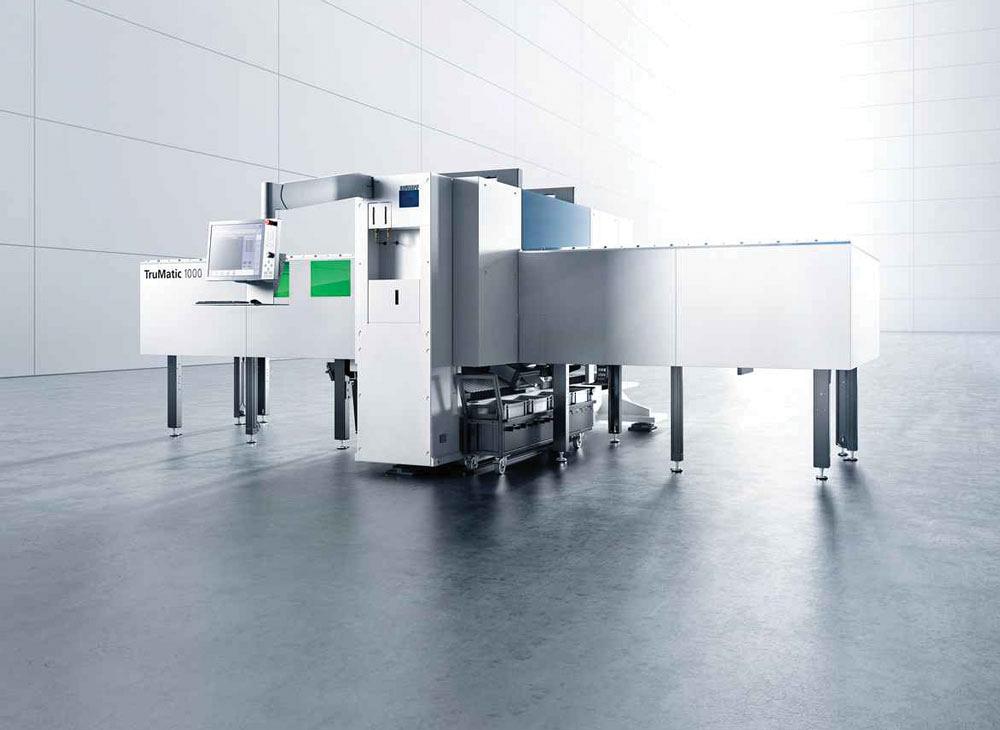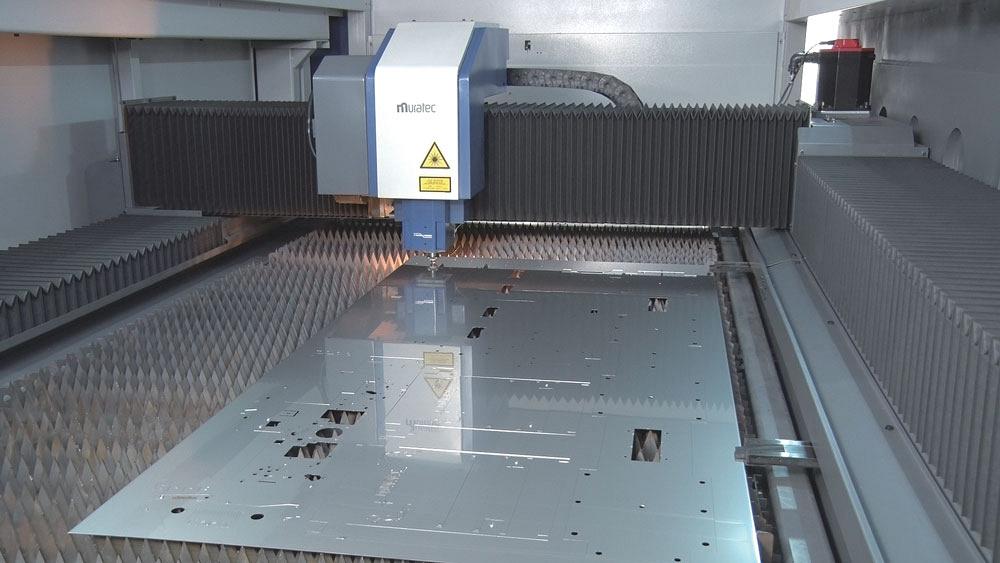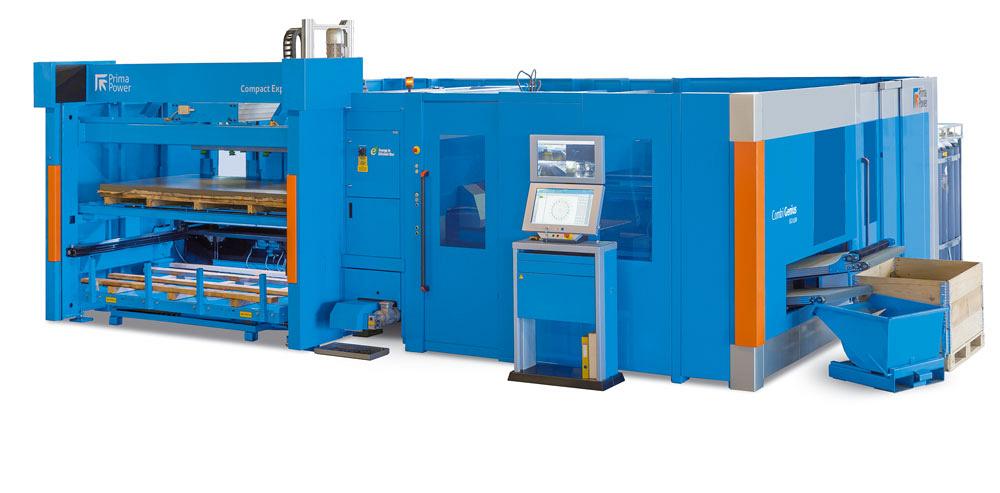Associate Editor
- FMA
- The Fabricator
- FABTECH
- Canadian Metalworking
The added benefits of punch/laser combination machines
Combining punch/laser capabilities reduces processing time, provides flexibility
- By Lindsay Luminoso
- April 18, 2019
- Article
- Fabricating

With a TruMatic machine, operators can take advantage of both punch and laser processing in a compact footprint. Photo courtesy of TRUMPF
To remain competitive, fabrication shops are required to take on new jobs with shorter lead times and more flexibility to meet customer needs. Investing in advanced equipment is one way to meet current market demands, and the punch/laser combination machine is one such option.
Combination machines have been around for the last 30 years, but it was only recently that they started to gain in popularity on the shop floor.
"In the machine tool world, the fibre laser has been so sought after," explained Roger Michaud, product group manager, TruPunch and TruMatic, TRUMPF, Farmington, Conn. "It just makes sense to combine the fibre laser with a punching press. This combination machine makes sheet metal production that much easier, and adding automation only increases the productivity of this workhorse."
Why a Combination Machine?
The experts agree that combination machines have a place in the market, but they haven’t reached a level where they are widely accepted just yet.
"I think this is because there’s a significantly more difficult ROI conversation with buying a machine that costs a significant amount of money," said Jeff Tyl, North American sales manager for fabrication products, Murata Machinery, Charlotte, N.C. Tyl said a customer can purchase a stand-alone punch press and laser potentially at a lower price than a combination machine. However, a combination machine allows shops to eliminate processes, reduce run time, optimize material handling, shift operators to other work, and incorporate automation in a way that a stand-alone machine cannot.
"We see several different types of customers that currently have punch technology but are looking at broadening their horizon," said Michaud. "These customers are looking to invest in a laser but are so familiar with the punch. A combination machine gives shops the opportunity to softly enter the laser market without the real cost of another machine."
A combination machine is ideal for prototyping and one-offs, particularly in situations where a shop processes different style geometries. The cost for special tools is eliminated by laser cutting instead. This is why the initial cost of the machine should be considered in conjunction with these cost-saving features and expanded capability to take on a wider range of jobs.
Fabricators may, at some point or another, have had to turn away work or outsource it because of limited capabilities.
"With a combination machine, shops are now able to in-source the work and actually do it on the laser," said Tyl. "Now there is a faster, more reliable way to do it that takes half the time and you don’t have multiple stations to run it on. You can do it on one station."
Shop Floor Considerations
"Investment cost is definitely a significant consideration," said Lutz Ehrlich, punching and automation product manager, Prima Power, Arlington Heights, Ill. "The other is floor space. There are ways to save floor space, but on the other hand, if a shop doesn’t have initial floor space to accommodate this machine, that could be challenging."

TRUMPF’s TruMatic 1000 fibre is a laser machine that punches holes, bends flanges, and forms threads. Photo courtesy of TRUMPF.
With added capabilities also comes a larger footprint, which can be a challenge, especially for small job shops. Customers are looking for a machine that is flexible enough to make all the components while taking up a relatively small space.
Having the necessary space is essential, but it’s also important to find the right spot on the shop floor to minimize bottlenecks.
"When you change the process, you need to know where your bottlenecks will occur," said Tyl. "Getting material on and off the table, turret, and laser itself is probably the biggest area of concern. Placing the machine in a location that minimizes this material handling optimizes the speed and processing power of the combination machine."
Process Improvements
One of the biggest process advancements that the experts have seen in recent years is the shift to fibre lasers.
Ehrlich explained that newer combination machines using fibre lasers don’t have vibration problems when cutting as there are no optical components outside the cutting head, whereas CO2 lasers and associated optical components in the beam path must be isolated from the punch vibration so that precision cutting can occur.
"The new generation of servo-electric punching machines has a very high flexibility in turret tooling use. Autoindexing, forming, up-forming, tapping, and other special tools, which can all be included in the active turret, reduce or eliminate frequent tool changes between different production runs," said Ehrlich. "Then we have the power of the fibre laser. Both individual modules (laser and punch) have a high-efficiency factor in electrical consumption, meaning there’s an operating cost significantly less and with less predictive maintenance intervals with these new technologies, producing products with less per-part cost."
This is why it is so important for shops to assess the projects they take on to determine where it is most cost-effective to laser-cut versus punch.
"We’re seeing a lot of shops going to this technology right now," said Michaud. "You’re saving a lot of time for the customer and a lot of investment, especially in your one-off case scenarios. However, if a programmer is skilled, he or she will avoid taking short cuts. Operators need to have a very good knowledge on what to punch versus laser-cut. This will keep the cost of a final part down. It’s really laser quality at a punch price."
Most machines on the market have a punching press infrastructure with fibre laser capabilities. However, some manufacturers have developed combination machines that use a fibre laser as the backbone with added punching capabilities.
"For the most part, the punch press is the major component and the laser is the minor," said Tyl. "However, we offer a laser that is the major component and forming as the minor with punch press technology, including a forming tool set and a tapping function, all in the same unit. It has the backbone of a laser versus the backbone of a punch."

Muratec’s LS3015HL Hybrid Laser multifunctional fabrication machine combines fibre laser cutting and forming into a single production center. Photo courtesy of Muratec.
Shops need to consider the type of jobs that they currently have, the material thicknesses they intend to work with, and the future applications that could be completed on a combination machine.
Misconceptions
The uptick in combination machines may be partly because shops only recently have begun to replace existing equipment.
"These machines have not been embraced as fast as lasers or stand-alone punch presses with automation," said Ehrlich. "With the technology advancements, some people look at a combination machine and believe that having a machine with both laser and punching processes means that they are only using 50 per cent of the machine at any given. But that’s simply not true."
Michaud said he believes that a large part of this reason is the misconception that the machine is slower and that it costs a lot. And although there is some truth to this, shops can take a part from raw material to completed product with fewer processes, allowing for close to lights-out operations.
"I think a lot of shops look at this machine and think, ‘I can eliminate one machine and one operator, especially when the costs of employees are obviously going up,’" added Tyl. "But that’s not necessarily true. You still need skilled operators, and this frees them up to train on something different. You can also add a second shift. As you move forward with a combination machine, what you’re doing is you’re actually enabling your workforce to grow."
Tyl added that another misconception is that a combo machine has a steep learning curve. However, for Tyl, the biggest learning curve tends to be longtime operators who are stuck in their ways and who may have never run a machine that does it all on its own.
"An operator is accustomed to hearing certain things and doing certain things that this machine probably doesn’t do because it’s much more efficient and kind of does it on its own," said Tyl. "It’s really a mindset change."
Advanced Technology
Combination machines offer fabricators the best of both worlds in one system. However, many customers don’t necessarily understand or know yet what these machines offer.
"Every day I have customers that have had our machines for 10 years come here and say, ‘Huh, I didn’t know you could do that,’" said Michaud. Whether it’s forming a hinge during the punch process option or tapping, customers are often surprised at the versatility of combination machines.
Considering the higher price of a combination machine, it’s really important for shops to familiarize themselves with all their features to maximize the investment. The experts agree that proper training is necessary, and many OEMs offer seminars and assistance when needed, along with guidelines for recommended software and tooling.

Leveraging the high speed of fibre laser cutting and accurate forming and tapping performance, this LS3015HL hybrid laser machine provides significant throughput increases. Photo courtesy of Muratec.
"Customers need to look at a machine that allows them to make a current product as well as looking to the future," said Tyl. "Fabricators really have to look and be forward-thinking to see how the options and processes will help grow the business."
Associate Editor Lindsay Luminoso can be reached at lluminoso@canadianfabweld.com.
Murata Machinery, www.muratec.net
Prima Power, www.primapower.com
TRUMPF, www.trumpf.com
About the Author

Lindsay Luminoso
1154 Warden Avenue
Toronto, M1R 0A1 Canada
Lindsay Luminoso, associate editor, contributes to both Canadian Metalworking and Canadian Fabricating & Welding. She worked as an associate editor/web editor, at Canadian Metalworking from 2014-2016 and was most recently an associate editor at Design Engineering.
Luminoso has a bachelor of arts from Carleton University, a bachelor of education from Ottawa University, and a graduate certificate in book, magazine, and digital publishing from Centennial College.
subscribe now


Keep up to date with the latest news, events, and technology for all things metal from our pair of monthly magazines written specifically for Canadian manufacturers!
Start Your Free Subscription- Trending Articles
Aluminum MIG welding wire upgraded with a proprietary and patented surface treatment technology

Hypertherm Associates partners with Rapyuta Robotics

Gema welcomes controller

Brushless copper tubing cutter adjusts to ODs up to 2-1/8 in.

HGG Profiling Equipment BV names Western Canada area sales manager

- Industry Events
MME Winnipeg
- April 30, 2024
- Winnipeg, ON Canada
CTMA Economic Uncertainty: Helping You Navigate Windsor Seminar
- April 30, 2024
- Windsor, ON Canada
CTMA Economic Uncertainty: Helping You Navigate Kitchener Seminar
- May 2, 2024
- Kitchener, ON Canada
Automate 2024
- May 6 - 9, 2024
- Chicago, IL
ANCA Open House
- May 7 - 8, 2024
- Wixom, MI
















